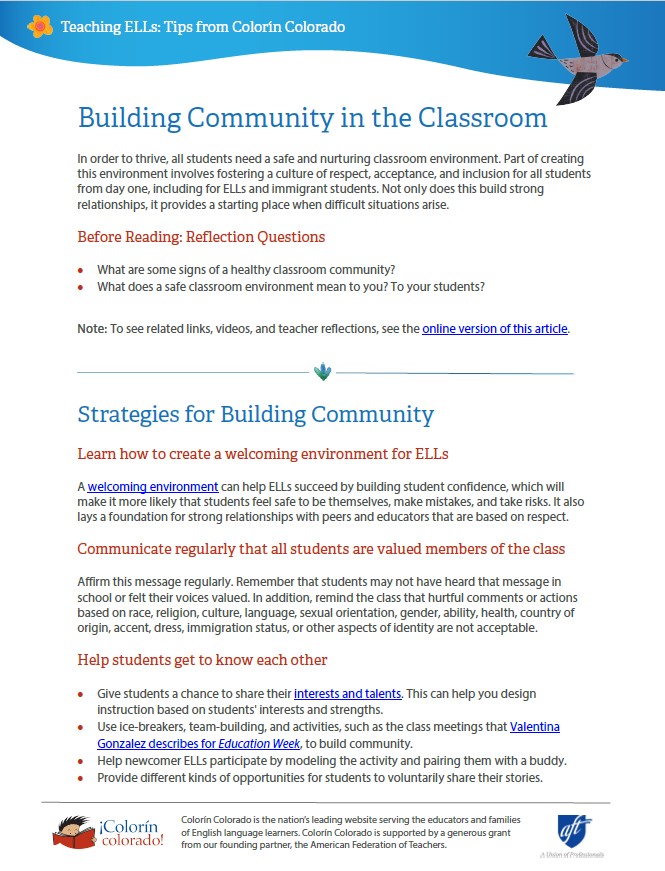Building Community in the Classroom

Learn how to build a strong, caring community in your classroom from the beginning of the school year and how to ensure that ELLs feel part of that community as well. This article is part of Navigating Tough Topics in the Classroom: Tips for ELL Educators.
Photo credit: Photo by Allison Shelley/The Verbatim Agency for EDUimages
Acknowledgements
 This project was made possible with support from the American Federation of Teachers.
This project was made possible with support from the American Federation of Teachers.
In order to thrive, all students need a safe and nurturing classroom environment. Part of creating this environment involves fostering a culture of respect, acceptance, and inclusion for all students from day one, including for English language learners (ELLs) and immigrant students. Not only does this encourage strong relationships, it provides a starting place when difficult situations and topics arise.
 Before Reading: Reflection Questions
Before Reading: Reflection Questions
- What are signs of a healthy classroom community?
- What does a safe classroom environment mean to you? To your students?
Strategies
Learn how to create a welcoming environment for ELLs
A welcoming environment can help ELLs succeed by building student confidence. This confidence makes it more likely that students feel safe to be themselves, make mistakes, and take risks. It also lays a foundation for strong relationships with peers and educators that are based on respect.
Communicate regularly that all students are valued members of the class
Affirm this message regularly. Remember that students may not have heard that message in school previously, nor felt their voices valued. In addition, remind the class that hurtful comments or actions based on race, religion, culture, language, sexual orientation, gender, ability, health, country of origin, accent, dress, immigration status, or other aspects of identity are not acceptable in the classroom.
Help students get to know each other
- Give students a chance to share their interests and talents. This can help you design instruction based on students' interests and strengths.
- Use ice-breakers, team-building, and activities such as the class meetings that Valentina Gonzalez describes for Education Week to build community. Help your newcomer ELLs understand these activities by modeling the activity and pairing them with a buddy.
- Provide different kinds of opportunities for students to voluntarily share their stories.
How to create a safe space for student stories
- Providing opportunities for students to tell their stories
- Building Bridges Through Storytelling: What Are Your Students' Stories?
- How Storytelling Inspires Children to Learn English (Edutopia)
Consider how to discuss identity in a safe way
Having students think about their own identity can help create an "identity-safe classroom" and also lay important groundwork for later discussions. It can also challenge the notion of "color blindness," a perspective which ignores important aspects of students' identity and experiences.
When discussing identity:
- Honor students' experiences and perspectives for what they are.
- Avoid assumptions.
- Beware the "danger of the single story."
- Keep in mind that students may be masking some part of their identity.
- Never put students on the spot as a "representative" of any aspect of their identity or experience.
For example, some Indigenous students from Latin America may not share their Indigenous culture or language with the school, or the fact that Spanish is not their first language. Consider how teachers can ensure that Indigenous students feel safe to share and celebrate their identities.
Learn more from our interview with Mam educator Henry Sales and our guide on partnering with Indigenous families from Latin America.
Resources
Elementary School
- Discussing Identity with Kindergarten Students (Education to the Core)
- Discovering My Identity (Learning for Justice)
Middle and High School
- Identity Web (Upstanders: How to Engage Middle School Hearts and Minds with Inquiry)
- Identity Charts (Facing History)
- Identity and Community: An Introduction to Social Studies (Facing History)
- Lesson Plan: Explore Identity (PBS)
- Who am I? (Channel Thirteen)
- Classroom Conversations About Identity and Difference (Folger Shakespeare Library)
- Social Identity Wheel (University of Michigan)
Professional development and collaboration
- Social Justice Standards: Unpacking Identity (Learning for Justice)
- Why Conversations About Identity Shouldn’t Be Framed as “Difficult” (Inside HigherEd)
- How to Respond to Colleagues Who Say They "Don't See Color" (Education Week)
Look for ways to tie learning to students' experiences
By connecting your instruction to students’ own experiences and their funds of knowledge, you can strengthen their connection to learning and increase their sense of confidence in the classroom — and also make your instruction more culturally responsive.
You can learn more in Culturally Responsive Teaching: Celebrating Diversity in Our Schools (NYSUT).
Teach empathy and appreciation
Look for activities that build empathy and gratitude. When students express their appreciation for each other, they can identify positive traits and behaviors in each other, build self-esteem, and bring things to your attention that you might have missed. This can be especially powerful when ELLs' strengths, talents, and positive traits have been overlooked.
For example, David Olio regularly gives his students note cards and asks them to write down a way in which a classmate helped their learning. Not only does it keep students’ contributions present in his mind, but he can do some informal assessment of the lesson.

